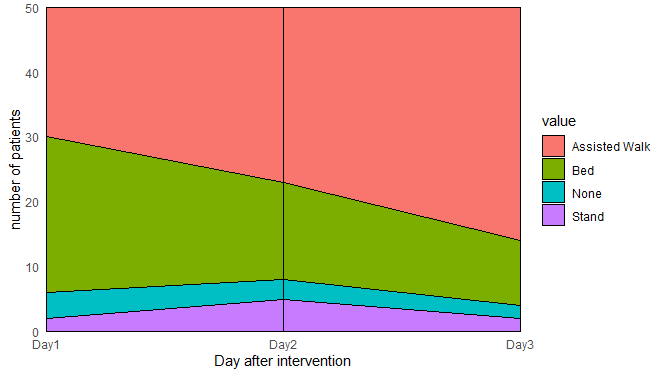still fairly new to R and have stepped away for a while, so please bear with me. I have a set of data which describes the degree of mobility (categorical data) after an operation across 3 days. I have been looking for a way to demonstrate the flow across those 3 days.
I've tried using geom_jitter with x and y being Day 1 and 2, and aes(colour) being Day 3 but this doesn't really convey what I want to show. I've done some reading around Sankey Diagram and Parallel Coordinates but have not got the understanding to quite fit the samples posed by others to fit my data.
This is what I've tried:
test %>% filter(!is.na(Mob_D1.factor) & !is.na(Mob_D2.factor) & !is.na(Mob_D3.factor)) %>%
ggplot(aes(x = Mob_D1.factor, y = Mob_D2.factor, colour = Mob_D3.factor)) +
geom_jitter(size = 5, alpha = 0.25, height = 0.25, width = 0.2) +
scale_colour_brewer(palette = "Dark2", name = "Mobilisation on Day 3") +
xlab("Mobilisation on Day 1") +
ylab("Mobilisation on Day 2") + theme_minimal()
As I said, not quite what I want.
This is a sample of the data:
structure(list(Mob_D1.factor = structure(c(2L, 2L, 2L, 2L, 4L,
1L, 2L, 2L, 1L, 4L, 2L, 4L, 2L, 1L, 2L, 4L, 4L, 2L, 4L, 4L, 2L,
4L, 2L, 2L, 4L, 2L, 1L, 4L, 4L, 3L, 4L, 2L, 3L, 2L, 2L, 2L, 2L,
2L, 4L, 4L, 2L, 4L, 4L, 2L, 2L, 4L, 2L, 4L, 4L, 4L), .Label = c("None",
"Bed", "Stand", "Assisted Walk"), class = "factor"), Mob_D2.factor = structure(c(2L,
3L, 2L, 4L, 4L, 1L, 3L, 4L, 4L, 4L, 3L, 4L, 2L, 2L, 2L, 4L, 4L,
4L, 4L, 4L, 1L, 4L, 2L, 2L, 4L, 2L, 1L, 4L, 4L, 4L, 4L, 2L, 3L,
2L, 2L, 2L, 4L, 4L, 2L, 4L, 3L, 4L, 4L, 2L, 2L, 4L, 4L, 4L, 4L,
4L), .Label = c("None", "Bed", "Stand", "Assisted Walk"), class = "factor"),
Mob_D3.factor = structure(c(2L, 3L, 2L, 4L, 4L, 1L, 4L, 4L,
4L, 4L, 4L, 4L, 4L, 2L, 4L, 4L, 4L, 4L, 4L, 4L, 2L, 4L, 2L,
2L, 4L, 4L, 1L, 4L, 4L, 4L, 4L, 2L, 4L, 4L, 2L, 2L, 4L, 4L,
3L, 4L, 4L, 4L, 4L, 2L, 4L, 4L, 4L, 4L, 4L, 4L), .Label = c("None",
"Bed", "Stand", "Assisted Walk"), class = "factor")), row.names = c(NA,
-50L), class = c("tbl_df", "tbl", "data.frame"))
Thanks in advance to anyone who takes the time to reply. Any extended explanation would be appreciated as I am still learning.
Larry

